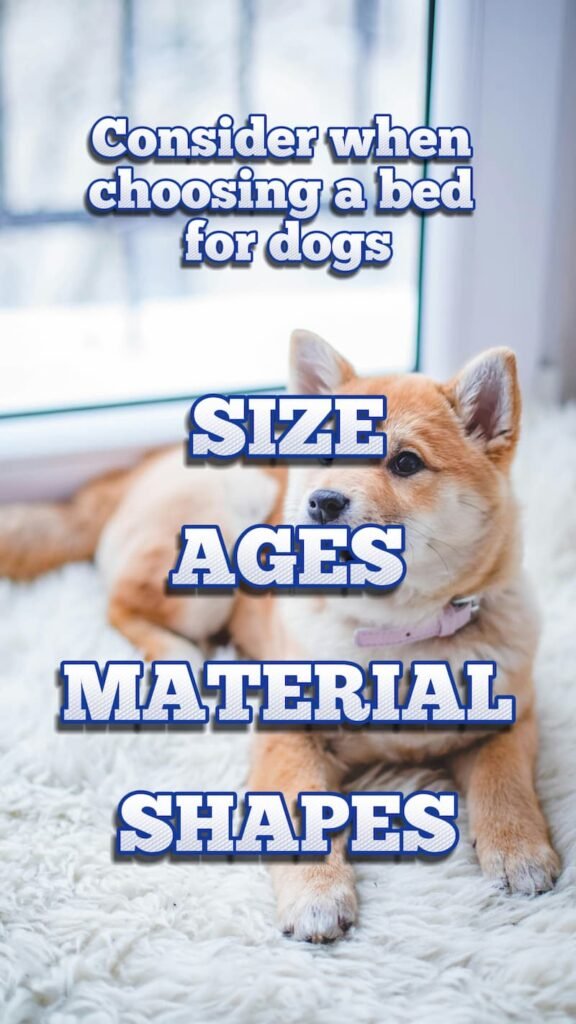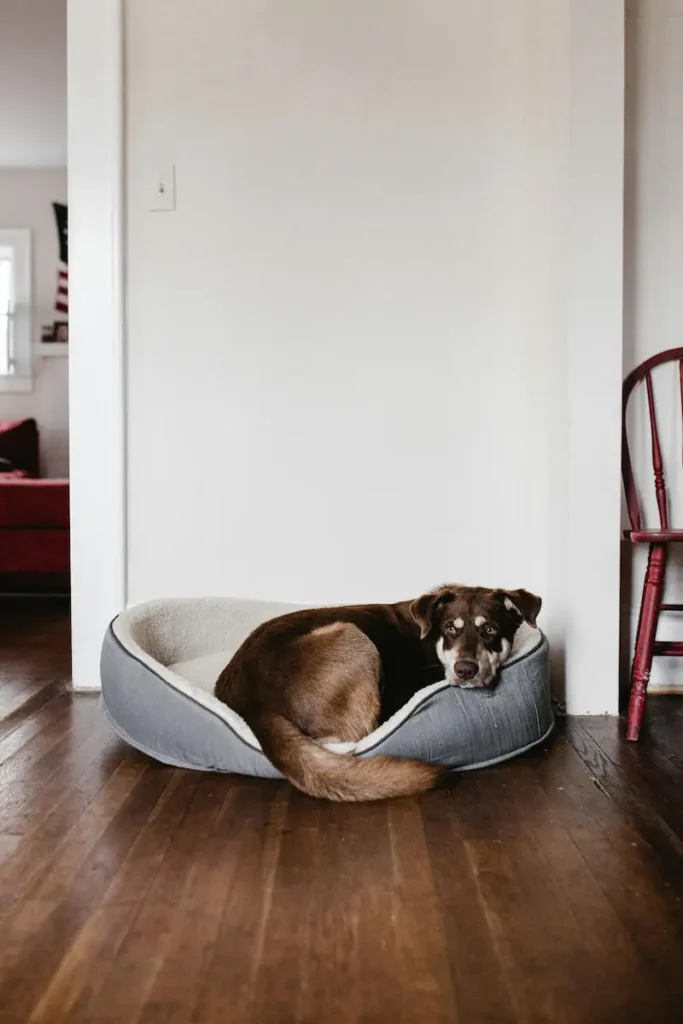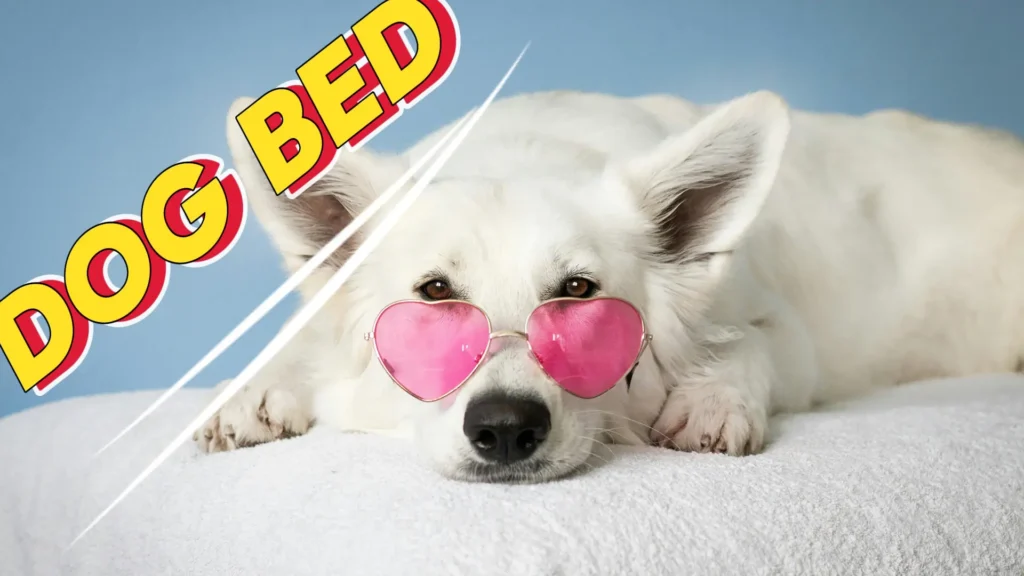Choosing the right dog bed is more than just picking a cozy spot for your furry friend to rest—it’s about ensuring their comfort, health, and happiness. With so many options available, finding the perfect bed can feel overwhelming. From size and support to durability and style, there are several factors to consider to meet your dog’s unique needs.

Choosing Dog Bed – Size and Fit
Your dog’s comfort and health depend on the right size and fit of the bed. Consider the matters below before choosing the bed. Here’s how to do it:
Measure Your Dog
Before buying a bed, measure your dog in their typical sleeping position:
- Length: Measure from the tip of the nose to the base of the tail.
- Width: Measure from shoulder to shoulder at the widest part.
- Extra Space: Add 6-12 inches to ensure they have room to stretch comfortably.
If your dog is 30 inches long, choose a bed that is at least 36–42 inches in length.
Consider Your Dog’s Sleeping Style
Dogs have different sleeping habits, and the bed size should accommodate their style:
- Curled-up sleepers → Choose a round or oval bed that offers a snug fit.
- Stretched-out sleepers → Opt for a rectangular or mattress-style bed to provide enough space.
- Leaning or snuggling dogs → A bed with bolsters or raised edges offers support and comfort.
Dog Bed Size Guidelines by Weight & Breed
Here’s a general size guide based on breed and weight:
Choosing The Right Bed
Weight- Bed Size- Breeds
| Dog Size | Dog Weight | Recommended Bed Size | Example Breeds |
| Small | Up to 25 lbs | 18-24 inches | Chihuahua, Pomeranian |
| Medium | 25-50 lbs | 30-36 inches | Cocker Spaniel, Beagle |
| Large | 50-75 lbs | 42-48 inches | Labrador, Golden Retriever |
| X-Large | 75+ lbs | 54+ inches | Great Dane, Mastiff |
Choose the Right Material for Your Dog’s Bed
Choosing a bed considering material and comfort for your dog. Here’s what to consider when selecting the right one:
Types of Materials
Different materials provide varying levels of comfort, durability, and maintenance.
a) Sleeping Surface Materials:
Plush/Fleece: Plush and fleece materials provide a luxuriously soft and cozy sleeping surface. These beds are particularly suited for small dogs and those that love to snuggle into their sleeping space. The plush texture is perfect for dogs that enjoy burrowing.
Cotton/Polyester Blends: Cotton and polyester blend beds offer a lightweight and breathable option. This material is ideal for dogs living in warmer climates. The fabric allows airflow to cool dog’s body. These materials are easy to wash and maintain.
Cooling Fabric: Designed with gel-infused and breathable mesh materials, cooling beds help regulate body temperature. These beds are especially beneficial for thick-coated breeds and brachycephalic dogs.
Faux Suede/Microfiber: Faux suede and microfiber materials combine softness with durability. These fabrics are resistant to stains and general wear, making them an excellent option for long-term use.
Canvas/Nylon: Canvas and nylon materials offer exceptional durability and resistance to wear and tear. These tough fabrics are designed to withstand rough handling. A canvas or nylon dog bed provides a sturdy and resilient sleeping space that holds up well over time.
b) Fill Material (Inner Cushion):
Memory Foam: This foam provides exceptional orthopedic support. Older dogs suffering from joint issues get benefit from this foam. This high-density material conforms to the dog’s body, offering pressure relief and even weight distribution. Additionally, memory foam retains its shape over time.
Polyfill (Fiberfill): Polyfill, also known as fiberfill, provides a soft and fluffy sleeping surface that delivers comfort for dogs seeking a cozy place to rest. This filling is lightweight and budget-friendly. However, while polyfill offers initial plushness, it may flatten over time with extended use, potentially leading to decreased support. These beds are best suited for light-use applications and for dogs that do not require significant orthopedic support.
Egg Crate Foam: Egg crate foam enhances airflow. This material provides moderate support. It is an excellent choice for dogs that require mild joint relief without the firmness of memory foam.
Shredded Foam: For pet owners looking for an environmentally friendly and budget-conscious option, recycled fiber or shredded foam beds are a great choice. These beds use repurposed materials to create a soft and supportive sleeping surface while reducing environmental impact.
Comfort Considerations Based on Your Dog’s Needs
Choose materials based on your dog’s age, health, and preferences:
Senior dogs: Memory foam or orthopedic beds for joint support.
Puppies: Soft and washable materials (polyester blends, fleece).
Dogs with allergies: Hypoallergenic materials like microfiber or organic cotton.
Active/chewers: Durable canvas or nylon to resist damage.
Warm climates: Breathable fabrics like mesh or cooling gel beds.
Cold climates: Plush or fleece materials for warmth.
Washability and Maintenance
Choose materials that are easy to clean and maintain. Choose removable and machine-washable covers for convenience. Go for water-resistant liners to prevent damage from accidents.
Choosing the Dog Beds Considering Ages
Choose the dog bed to provide comfort, support, and well-being as they grow and age. Different life stages come with varying needs, so here’s what to consider for puppies, adult dogs, and senior dogs.

Puppy Beds
Puppies are energetic, curious, and prone to chewing. So, their bed should focus on durability and comfort. Key features to look for when choosing beds for puppies:
Durable Materials: Opt for chew-resistant fabrics like canvas and heavy-duty nylon to withstand teething.
Washable Covers: Puppies confronts accidents frequently. So, machine-washable, waterproof covers are essential for easy cleanup.
Soft, Supportive Padding: Choose a plush or polyfill bed to provide comfort for growing bodies.
Budget-Friendly: Since puppies will outgrow their beds, an affordable option that balances comfort and durability is ideal.
Adult Dog Beds
Adult dogs require a balance of comfort and support tailored to their activity level, breed, and size. Key features to look for when choosing bed for adult dogs:
Size Appropriateness: Choose a bed that accommodates their full adult size with enough room to stretch out.
Material Based on Sleeping Style:
Plush beds for cuddlers
Orthopedic foam for joint support in larger breeds
Cooling gel beds for dogs prone to overheating
Durability for Active Dogs: Heavy-duty fabrics for dogs that chew or scratch frequently.
Removable Covers: To maintain hygiene with regular washing.
Senior Dog Beds
As dogs age, they develop joint issues, arthritis, and mobility problems. So, their beds should focus on providing extra support and accessibility. Key features to look for when choosing beds for senior dogs:
Orthopedic or Memory Foam: Provides pressure relief and joint support for dogs with arthritis or hip dysplasia.
Low-Profile Design: Easier for senior dogs to step onto without strain.
Temperature Control: Heated beds for cold-sensitive seniors or cooling beds to prevent overheating.
Waterproof Liners: Protect against accidents related to incontinence.
Non-Skid Bottom: Prevents slipping when getting on and off the bed.
Choose the Right Shape for Your Dog’s Bed
Round or Oval Beds
The rounded shape naturally encourages a curled-up sleeping position. This shape helps to retain body heat and offers a comforting space. Typically suited for small to medium-sized breeds, these beds often come with cushioned sides that provide additional support for the head and neck.
Rectangular Beds
Rectangular or mattress-style beds offer ample space to stretch out. These beds provide a flat, open surface that allows dogs to sprawl in any direction. This shape is ideal larger breeds and those that frequently change positions during sleep. Mattress-style beds feature thick padding and orthopedic foam to support a dog’s weight evenly and provide relief for joints and pressure points.
Bolster Beds
Bolster beds feature raised edges on one or more sides. This is suitable for dogs that enjoy leaning and resting their heads while they sleep. These beds provide a sense of enclosure without being too restrictive.
Donut Beds
Donut-shaped or nest beds are designed with a round, cushioned center surrounded by raised edges. These beds are ideal for small breeds and puppies for a comfortable retreat. The soft, plush materials used in donut beds help to create a soothing environment that can ease anxiety and promote better sleep.
Hooded Beds
Cave or hooded beds are perfect for dogs that prefer a secluded sleeping space. These beds feature a covered top that provides privacy and warmth. The enclosed design helps create a den-like atmosphere, which can be comforting for dogs that enjoy burrowing and hiding.
Selecting the right dog bed is an investment in your pet’s well-being. By considering factors above, you can provide them with a comfortable and safe place to rest. Take the time to evaluate your options, and you’ll find a bed that both you and your furry companion will love. 🐾




